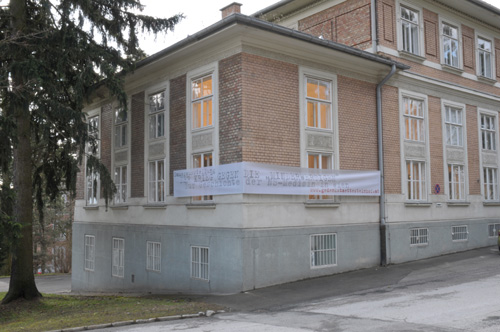An exhibition by the Documentation Centre of Austrian Resistance
Otto-Wagner-Areal, Pavilion V, Baumgartner Höhe, 1140 Vienna
Opening hours
Wednesday through Friday (on workdays) 10 a.m. to 5 p.m.
Saturday (including holidays) 2 p.m. to 6 p.m.
December 24 and December 31: closed
Free admission
Contact
Documentation Centre of Austrian Resistance
e-mail | phone: +43 1 22 89 469-800 (mon to fri, 8-15)
 In the National Socialist system, medicine took on a new task: the "weeding out" of people designated as "inferior." There was no room in the performance-orientated Volksgemeinschaft (people’s community) for the handicapped, the mentally sick, for members of social fringe groups, and nonconformists. They were persecuted, imprisoned, and abandoned to annihilation.
In the National Socialist system, medicine took on a new task: the "weeding out" of people designated as "inferior." There was no room in the performance-orientated Volksgemeinschaft (people’s community) for the handicapped, the mentally sick, for members of social fringe groups, and nonconformists. They were persecuted, imprisoned, and abandoned to annihilation.
The Heil- und Pflegeanstalt "Am Steinhof" (today's Klinik Penzing) developed in the years after the Anschluss of 1938 into the Viennese center of National Socialist medical murder that was to take the lives of far more than 7,500 Steinhof patients:
- Between 1940 and 1945 a so-called "children's ward" named Am Spiegelgrund existed on the Steinhof premises where approximately 800 sick or handicapped children and young people perished.
- In the course of the so-called "Operation T4," more than 3,200 patients were deported from the clinic in 1940/41 and murdered in Hartheim Castle near Linz.
- After the official halt to "Operation T4" in August 1941, "euthanasia" was continued within the clinic by means of deliberate malnutrition and systematic neglect. More than 3,500 patients fell victim to hunger and infection.
Remains of victims of the "Am Spiegelgrund" clinic were used in medical research until the 1980s. They were interred in an honorary grave at the Vienna Central Cemetery only in 2002. Additional Spiegelgrund preparations as well as remains of victims of the "decentralized euthanasia" at Steinhof were put to rest in May 2012.
Starting out from the occurrences at the Steinhof clinic compound, the exhibition in Pavilion V of the Penzing clinic offers a comprehensive overview of the circumstances and consequences of Nazi medical crimes in Vienna.




















 English
English Termine
Termine Neues
Neues






